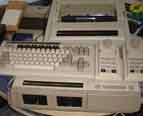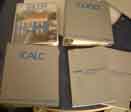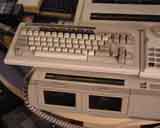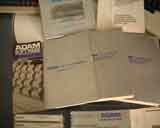
Originally an expansion unit for the Colecovisionconsole, this Z80 based add-on became a fully fledged machine in its own right
in its short 2 year lifespan. One of its design goals was to get round the unreliable
tape loading of other machines, and this was fulfilled by the digital cassette
which was under full software control - an index was kept in the middle of the
tape making searches a bit faster than normal. The downside was the digital
format was proprietary and the preformatted tapes could only be bought from
Coleco. The other thing against it was cost - $700 for an unremarkable BASIC
and word processor did not a popular machine make. Pity really; the hardware
is excellent, the digital tape idea was also smart but flawed in tape availability
and it contained the usual Colecovision goodies that made the Colecovision such
a popular console.
Oh, and power was provided through the printer, so if it died so did yer machine. This was one of ADAM's annoyances - you had to have everything powered on just
to play a game, also because the index was in the middle of the cassette the
thing had to be rewound before loading something else so loading times could
be measured in minutes.
Today there's still a thriving ADAM hobbyist scene, with people producing hardware addons for it such as hard disk interfaces and extra memory. There's even still
an ADAM Convention for fellow hobbyists to meet, greet, swap ideas and no doubt
drink copious quantities of alcohol :)
Here's a mail from Martin Scott Goldberg over at ClassicGaming:
"It was basicly a Z80 based micro with it's sound and graphics based around
the Texas Instruments TMS9928A for graphics and SN76489AN for sound (both
of which were already in the Colecovision). If it sounds familiar, it's
because it's similar to the TI99/4A and what became part of the MSX
stanadard. It also had 64K of RAM, along with 16k of Vram (which is why
you'll often see it advertised as having 80k of RAM). From my
understanding it's a dual Z-80, supplying it's own Z-80 and having access
to the one in the Colecovision portion."
the Texas Instruments TMS9928A for graphics and SN76489AN for sound (both
of which were already in the Colecovision). If it sounds familiar, it's
because it's similar to the TI99/4A and what became part of the MSX
stanadard. It also had 64K of RAM, along with 16k of Vram (which is why
you'll often see it advertised as having 80k of RAM). From my
understanding it's a dual Z-80, supplying it's own Z-80 and having access
to the one in the Colecovision portion."
"It consisted of three components connected through a serial net
called ADAMNET. Consequently, all three components (The daisywheel
printer, the main chasis, the keyboard) had to be connected for the Adam
to function. If you were missing the printer for example (which the power
was actually supplied through), you couldn't start up your Adam."
called ADAMNET. Consequently, all three components (The daisywheel
printer, the main chasis, the keyboard) had to be connected for the Adam
to function. If you were missing the printer for example (which the power
was actually supplied through), you couldn't start up your Adam."
"The main chasis had a special storage medium called a High Speed Digital
Data Pack, with an empty section for a second one to be added. They were
basicly a type of DAT used for storage, and most of the Adam's software
was distributed on these. "
Data Pack, with an empty section for a second one to be added. They were
basicly a type of DAT used for storage, and most of the Adam's software
was distributed on these. "
"Inside you had 3 card slots where you could add things like an internal
modem (which I have), extra ram, or whatnot. There was also a bus
expansion slot as well. There were cards made at the time to add seperate
printers, expand the memory an additional 256k, etc. Later 3rd part
expansions included adding a couple megs of memory, hard drives, etc."
modem (which I have), extra ram, or whatnot. There was also a bus
expansion slot as well. There were cards made at the time to add seperate
printers, expand the memory an additional 256k, etc. Later 3rd part
expansions included adding a couple megs of memory, hard drives, etc."
"You could also add a 160k 5 1/4" floppy drive developed by Coleco,
as well
as a cd-rom by Coleco as well (though this didn't see any real
mass-production)."
as a cd-rom by Coleco as well (though this didn't see any real
mass-production)."
"The first batch had to basicly be returned or refubished because of
production errors, and the company spent so long promising it on the
market that by the time it actually got there it was to late to do
anything. Interestingly, the company cancelled two products to put it's
focus on the Adam. The first being the original expansion module #3 for
the Colecovisionin 1983. This was to expand the capabilities of the
Colecovision and use special program wafers instead of cartridges, that
would have given the Colecovision NES (Nintendo Entertainment System) or
SMS (Sega Master System) level hardware support long before anyone heard
of the two. The second was when they canned the Colecovision alltogether
in 1984 to focus on marketing the Adam (as many companies felt at the time
of the '84 crash that the future was in computers and not game consoles)."
production errors, and the company spent so long promising it on the
market that by the time it actually got there it was to late to do
anything. Interestingly, the company cancelled two products to put it's
focus on the Adam. The first being the original expansion module #3 for
the Colecovisionin 1983. This was to expand the capabilities of the
Colecovision and use special program wafers instead of cartridges, that
would have given the Colecovision NES (Nintendo Entertainment System) or
SMS (Sega Master System) level hardware support long before anyone heard
of the two. The second was when they canned the Colecovision alltogether
in 1984 to focus on marketing the Adam (as many companies felt at the time
of the '84 crash that the future was in computers and not game consoles)."
"When the Adam failed in the market because of the long delays and quality
problems, it was pulled in '85. (I was a stock holder at the time, and
still have a bunch of the big color stock portfolios they'd release to
shareholders). It's other claim to fame was almost nixing a deal (which
never went through) between Nintendo and Atari. To put it breifly,
Nintendo had approached Atari to distribute it's system in the US. They
had several meetings, one of which was to be at the Summer '84 CES. It
turned out Coleco was showcasing the Adam at that show as well, along
with a datapack called Super Donkey Kong (an expanded version of it's
original Donkey Kong cartridge that it had licensed from Nintendo for the
Colecovision - it came packed in with the original Colecovision game
console). Atari had the exclusive license from Nintedo for Donkey Kong on
home computers, and threw a stink and threatened to nix the distribution
deal (which never occured, and the Atari computer and console divisions
were sold the next month to the Tramiel family). Consequently, Coleco
pulled the game from it's computers."
problems, it was pulled in '85. (I was a stock holder at the time, and
still have a bunch of the big color stock portfolios they'd release to
shareholders). It's other claim to fame was almost nixing a deal (which
never went through) between Nintendo and Atari. To put it breifly,
Nintendo had approached Atari to distribute it's system in the US. They
had several meetings, one of which was to be at the Summer '84 CES. It
turned out Coleco was showcasing the Adam at that show as well, along
with a datapack called Super Donkey Kong (an expanded version of it's
original Donkey Kong cartridge that it had licensed from Nintendo for the
Colecovision - it came packed in with the original Colecovision game
console). Atari had the exclusive license from Nintedo for Donkey Kong on
home computers, and threw a stink and threatened to nix the distribution
deal (which never occured, and the Atari computer and console divisions
were sold the next month to the Tramiel family). Consequently, Coleco
pulled the game from it's computers."
"As an expansion module, the Adam represents one of the few tangible
representations of the promise of what I call the "holy grail" of video
game companies of the late 70's and early 80's. The promise to turn their
video game console in to an actual programmable computer."
representations of the promise of what I call the "holy grail" of video
game companies of the late 70's and early 80's. The promise to turn their
video game console in to an actual programmable computer."
Thumbnails: (click for bigger picture)
The ADAM itself:
 |  |  |  |
 |  |  |  |
 |  |  |  |
 |  |  |  |
Rest of the full system, with software and extra joysticks.
 |  |  |  |
 |  |  |  |
 |  |  |  |
Related pix
ADAM says hello :)